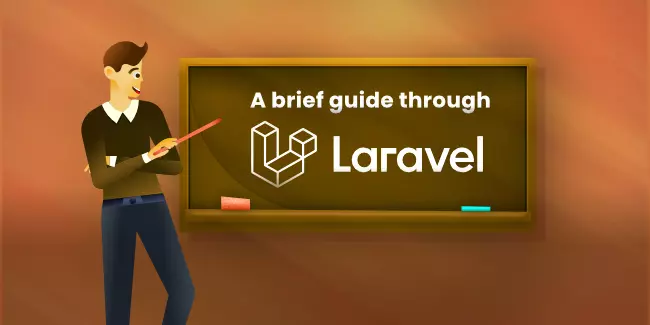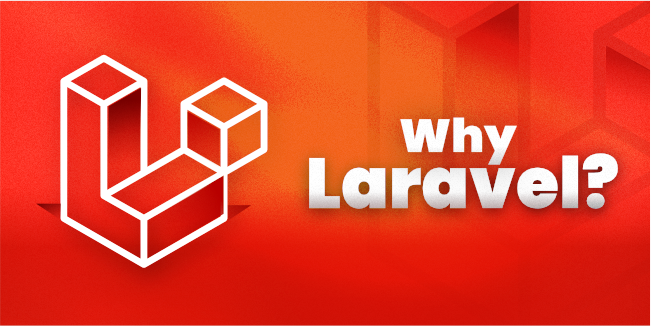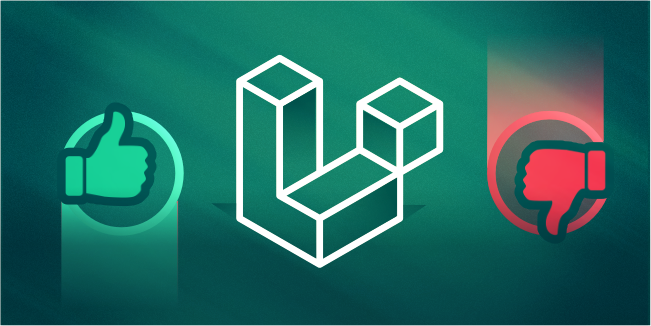Web Development
Technologies
A brief guide through Laravel

Creating a website or web application is associated with the need to make many difficult decisions. It isn't easy, especially if the software development plan is not finished to the last detail and you are not a technical person.
To avoid stress, decide to participate in Discovery Workshops, which will introduce you to the secrets of creating digital products. This workshop aims to thoroughly analyze your application idea, define the exact stages of development and find solutions that will make your work result in a great product within the set budget and time frame.
Since the choice of programming language is crucial to the entire project, ask for the advice of a trusted software development partner who has a rich company tech stack and will be able to advise you on the best solution. In the article "Choosing the right software partner - guide (2022)", you will find some tips to make this task easier.
The programming language you choose is essential. The article below covers all of the critical aspects of this decision.
What is Laravel?
Laravel is a cross-platform PHP framework for building web applications. It's a server-based platform that manages data using the Model-View-Controller (MVC) design pattern, dividing an application's backend architecture into logical pieces.
Now that the definition is behind us, it must be fully understood. For this reason, we need to understand what the PHP Framework is. It is a set of code libraries with pre-programmed valuable functionalities such as an authentication tool, rooting tool, or HTML templates that allow users to build applications faster. Larevel's best PHP framework speeds up the web development process and improves the quality of the final product.
Laravel web applications are highly scalable and have well-structured codebases. Laravel's modular packaging system and strong dependency management allow developers to expand the functionality of their apps quickly.
Taylor Otwell created Laravel as a more sophisticated replacement for the CodeIgniter framework, which lacked certain features such as built-in user authentication and authorization support. Laravel's first beta version was released on June 9, 2011, with the Laravel 1 release coming later that month. Laravel developers are still tweaking bugs and improving functionality in updates and new versions.
The newest version, the Laravel 8, continues the improvements made in earlier versions by introducing tons of new tools such as model factory classes, migration squashing, job batching, improved rate-limiting, or even Laravel Jetstream.
Is Laravel Frontend or Backend?
Laravel is a backend development framework. It also has some frontend capabilities. Laravel has front-end-style building tools like validation systems, dynamic queries, and pagination so that developers can focus on other, more engaging things in code.
What does Laravel do?
Laravel has tools that help you build web apps easier and faster. And when you are done, the codebase is well-structured and easy to maintain.
This PHP framework is known and willingly used by web developers. The fact that so many websites are created with its aid indicates it was not a random choice. What's more, this solution is used by companies such as 9GAG, Pfizer, or TourRadar. As one of the few PHP frameworks, Laravel can boast remarkable versatility and universality. It is used by companies specializing in IT, medicine, finance, travel, sales, entertainment, and others. Thanks to this versatility, they can build:
- social networking sites,
- e-Commerce web sites,
- multi and single-page applications (MPAs and SPAs),
- static and dynamic websites,
- enterprise-level applications,
- content management systems, and more.
What does Laravel contain?
Many modern PHP frameworks are object-oriented. It is good to understand some of the basics of classes and objects before using them.
MVC Architecture
The Model-View-Controller (MVC) architectural pattern is a set of rules that explains how to construct successful web apps easily and straightforwardly. This main Laravel framework pattern helps bring order to the unstructured code. Thanks to MVC support, the process of web applications development is quick and convenient, no matter if they are large or small.
Artisan CLI
The Artisan Command-Line Interface (CLI) is a tool for web developers which helps them migrate data, manage databases, create the basic code, controllers, models, and other parts of an app. With Laravel's CLI, web developers can create MVC files and issue their commands. It significantly simplifies and shortens the development process.
Blade Template Engine
The Blade Template Engine is a simple but essential and powerful templating engine. It allows for connecting data models, processing the application's code in the source templates, directing the output to a certain text file or stream. That makes the whole process much more convenient. This templating engine is fast, secure, and easy to use.
Eloquent ORM
The Eloquent Object-Relational Mapper (ORM) is a tool for working with databases. It helps establish and maintain essential communication between a web application's architecture and its databases. The ORM uses an expressive PHP Syntax that is integral to the language of the framework, which means saving time and effort.
Redis
Redis is an open-source, advanced key-value store. Because keys can contain strings, hashes, lists, sets, and sorted sets, it is commonly known as a data structure server. Laravel uses Redis to connect to an existing session and general-purpose cache. Redis interacts with the session directly.
Why Laravel?

When using Laravel, you have complete control over user authentication and role-based access control. The authentication system consists of all necessary steps, such as Login, Registration, and Password Reset, executed with a single command. All the required settings are included by default. As a result, account verification and access restriction are more complex, making them more secure.
Laravel packages is a system which goal is to automate user requests. It allows you to use add-ons and modules, specialized software extending web applications. Laravel uses a composer as a dependency manager, which keeps track of all the data necessary to handle packages. Packages are a great way to speed up the development process by giving us all the essential features.
Apart from the framework itself, Laravel has a lot more to offer. The expanding popularity of the framework has resulted in more diverse needs: packages, development environments, and the like. There are so many elements under the Laravel brand that they form a kind of ecosystem.
Here's one of the most interesting and popular components:
Sail
Sail is a lightweight command-line interface for interacting with Laravel's default Docker development environment. Without requiring prior Docker experience, Sail provides a fantastic starting position for creating a PHP, MySQL, and Redis-based Laravel application. Many developers consider Sail the better, more convenient, and versatile Homestead alternative.
Valet
Valet is a small, fast, low-resource (with about 7 MB of RAM) macOS development environment. It's not meant to be a total replacement for Sail or Homestead. Instead, it's designed for people with specific requirements because it provides a great alternative if you want flexible basics, prefers extreme speed, or work on a machine with limited RAM.
Cashier
Laravel Cashier is an interface for subscription billing services from Stripe or Paddle. Cashier handles essential subscription management, but it also allows you to manage coupons, subscriptions quantities, swap subscriptions, cancel grace periods, and even generate invoice PDFs.
Spark
Laravel Spark is a billing management panel that allows users to create and manage their subscriptions. Directly uses the engine on which it is based - Cashier. Spark is restricted to Stripe and Paddle as payment providers; Spark does not yet support custom providers. However, Spark can use third-party applications because they may be customized.
Pros and Cons

Laravel is considered to be one of the best PHP web frameworks. The list of advantages developers mention is often endless, but that does not mean that it doesn't have its flaws.
When choosing a web application development tool, you should understand your needs and select a tool to meet these requirements. We present what Laravel is good at and where its functionality ends. Let's start with the pros:
Great Documentation
One of the most significant advantages of Laravel is how developer-friendly this framework is. Since developers created it for developers, the creators of Laravel made sure that everything contained in their work was understandable and well described. Every variation of Laravel comes with clear instructions of classes, coding style, methods, and made changes.
PHP Support
PHP language is constantly evolving, and new features are added that are not supported by older development tools. It is not the case in Laravel. Thanks to backward compatibility using version 5.5 and newer, you can use new functions provided by PHP, for example, new interface, overloading, shorter array syntax, or namespaces.
Artisan
Although we covered this tool before, it is worth mentioning as a huge advantage because of its use in saving time-consuming work creating the skeleton code, letting you do the rest while not focusing on common tasks.
Connection to Mail
One of the advantages is connecting with mail services without any problems or worrying about the coding and/or security issues. Web apps must stay in touch with their users and inform them about new deals and offers. The framework uses an API rather than the SwiftMailer library. It also includes SMTP drivers, Mailgun, SparkPost, Mandrill, PHP's "mail" function, Amazon SES, and "send an email," allowing you to send emails through local services or cloud-based platforms.
It is these advantages that convince software developers to use Laravel. For the sake of completeness, let's now get to know the disadvantages of this framework:
Weak Composer
In contrast to many other languages, Laravel's composer isn't powerful compared to Ruby gems, npm (node.js), pip (for python), or other package managers.
Quality Swings
Not all framework elements are perfectly created or even good enough compared to the rest of the content. For example, dependency injection might occasionally become unnecessarily complicated. As a result, Laravel is not always made for amateurs and requires constant learning.
Bitter Sweet Updates
It is a problem not only for Laravel but also for PHP frameworks. Sometimes the update significantly improves your web application's performance, but sometimes we dream to go back to the previous version because we cannot find ourselves in the new edition. It's best to save everything twice before moving on to the next version.
Wrapping up
Laravel is a fantastic web development tool, and in many aspects, it has no competition. It also has an extensive ecosystem that is constantly growing, thanks to which an increasing variety of developers will find more ways to use Laravel for web development. It is significantly different from other web frameworks, but that is not a downside. In addition, the meticulousness of its creators allows you to familiarize yourself with the way it operates efficiently, and its use is a pure pleasure.
If you want to discuss your project, arrange a free consultation with our specialists. We have a wide range of successful projects and will be happy to advise you on the best technology stock for your project.